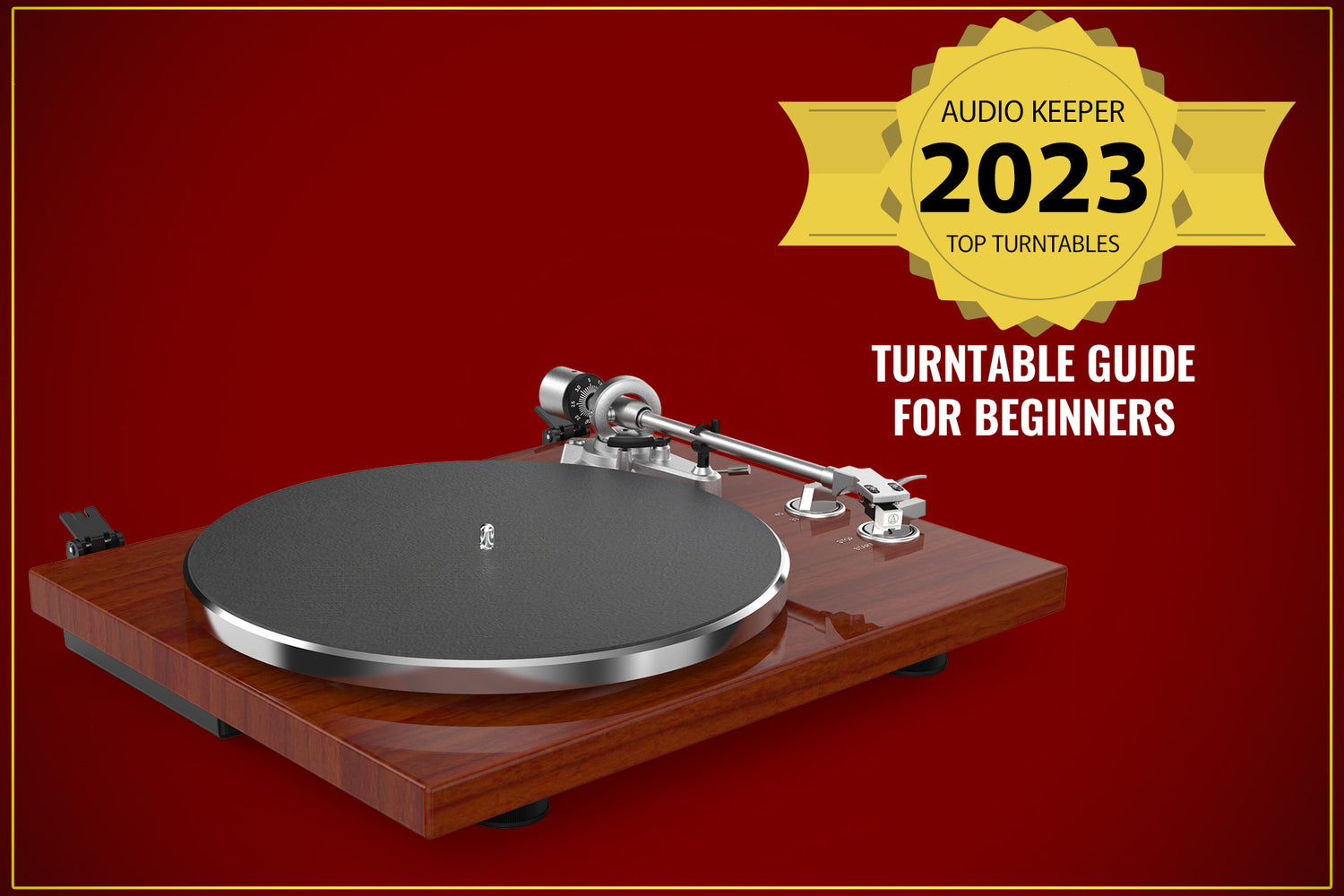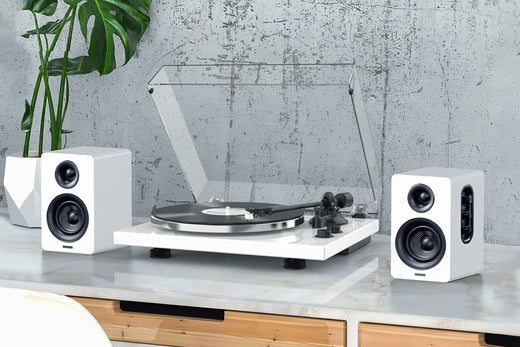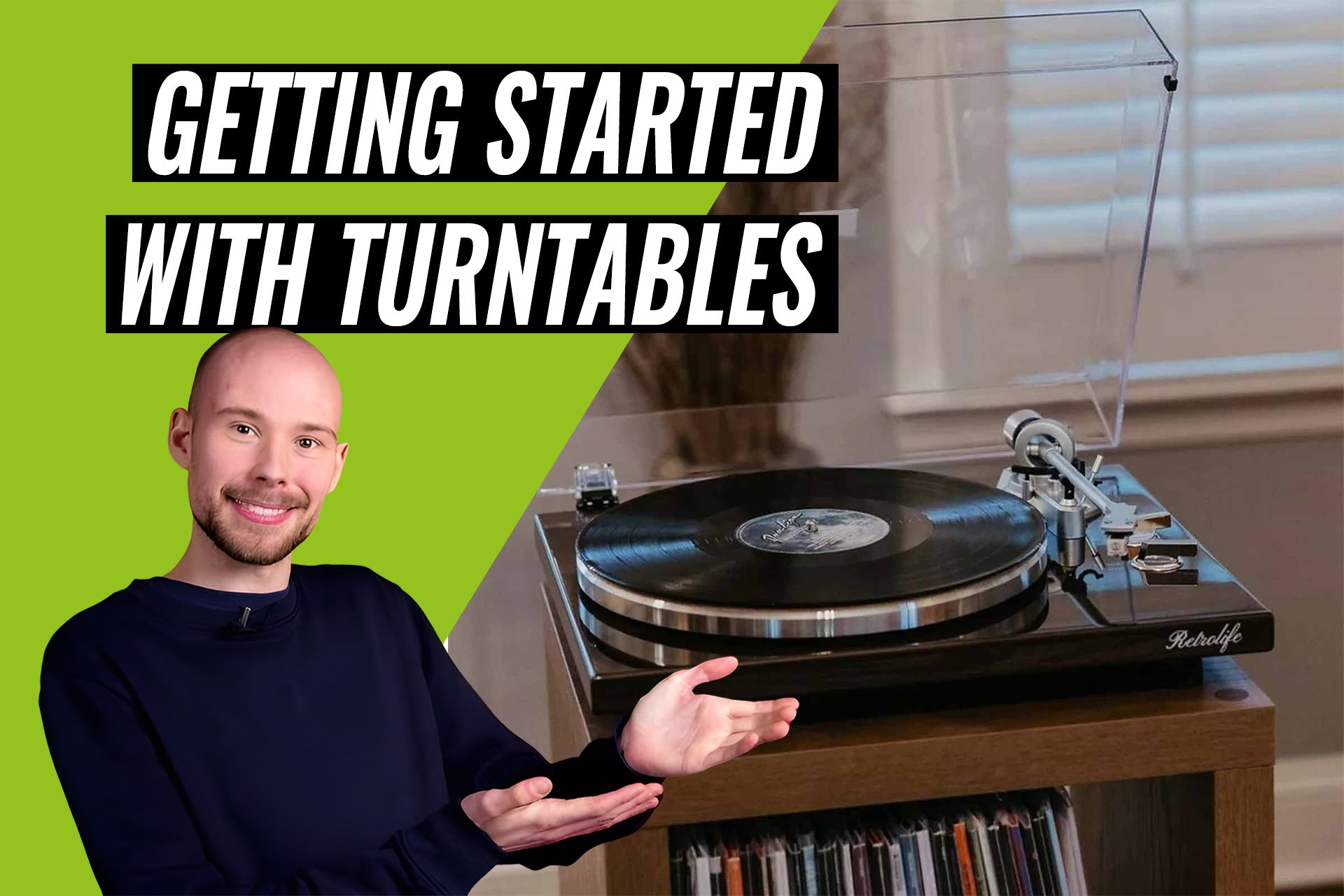Introduction
Welcome to our brand website, a professional brand focusing on the production and sales of high-fidelity vinyl turntables, turntable sound systems and accessories. For beginners, purchasing the ideal vinyl turntable may require some guidance and understanding. This blog will provide you with a comprehensive vinyl turntable buying guide to help you make an informed choice and gain insight into sound systems and related accessories.
Part One: Vinyl Turntable Basics
1.1 What is a vinyl turntable?
The vinyl turntable, as one of the classics in the audio world, carries a strong sense of nostalgia and musical taste. A deeper understanding of how vinyl turntables work and why they are so revered will take you on an amazing musical journey.
Working principle
- 1. Rotation of records: One of the most basic working principles of a vinyl turntable is the rotation of records. The record is placed on the turntable and the motor is responsible for making the turntable spin. This process is both an aesthetic expression and the key to audio information transmission.
- 2. Movement of the tone arm: The tone arm is the part that connects the turntable and the cartridge. As the turntable rotates, the tonearm moves automatically, placing the cartridge precisely on the designated track on the record. This mechanical process ensures that the cartridge accurately reads the audio information on the record.
- 3. Reading of the phono cartridge: The phono cartridge is an important part of the vinyl turntable. It is responsible for converting the unevenness on the record into electrical signals. This signal is then amplified and sent to the audio system, where it is ultimately presented as sound through the speakers.
Functions of different parts
- 1. Turntable: The turntable is the core of the entire system, and records are played through its rotation. Materials and manufacturing processes have an important impact on sound quality and durability.
- 2. Tone arm: The design of the tone arm directly affects the reading quality of the record by the cartridge. The lightweight, stable tonearm allows for more precise movement, improving the accuracy of the audio signal.
- 3. Cartridge: The cartridge is a key component that converts mechanical vibrations into electrical signals. A high-quality cartridge can better capture audio information and present clearer, more realistic sound.
Why is it so beloved?
- 1. Warm sound quality: Vinyl records are known for their unique sound quality. Compared with digital audio, vinyl sounds warmer, richer in detail and dynamic range, giving listeners an immersive music experience.
- 2. Nostalgia and taste: The vinyl turntable is not only an audio device, but also a cultural symbol. It reminds people of the past, closely links music with nostalgic emotions, and has become a fashion symbol pursued by music enthusiasts.
- 3. Combining music and art: The large sleeves of vinyl records and the records themselves are often works of art. Owning a vinyl record is not only an appreciation of music, but also a pursuit of art, making the entire music experience richer.
1.2 Why choose vinyl?
Vinyl records, as one of the classic music media, have always been loved by music enthusiasts for their unique sound quality and music experience. In today's era of digital audio, why do vinyl records still have a place in the music industry? This section will delve into the appeal of vinyl, as well as some of the unique advantages of choosing vinyl for beginners.
The uniqueness of vinyl sound quality
- 1. Warm tone: Vinyl records have a warmer tone, presenting a unique audio texture. Compared with the coldness of digital audio, the sound of vinyl is more humane and immerses the listener.
- 2. Wider dynamic range: Vinyl records can provide a wider dynamic range, that is, the range of audio intensity changes is wider. This means you can feel the nuances of the notes in a song more clearly, resulting in a richer, three-dimensional listening experience.
- 3. Natural analog sound effects: The analog sound effects of vinyl records are more natural and closer to the performance of real music scenes. This makes vinyl the first choice for music enthusiasts who like to pursue the original music feel.
A unique experience with vinyl records
- 1. Artistic cover design: Vinyl records are not only a carrier of music, but also a work of art. The artistic elements presented in its jacket design and album interior pages inject more cultural connotation into the music, making it a unique pursuit of collectors and music lovers.
- 2. Personal music experience: Place the vinyl record, gently lift the tone arm, and wait for the music to sound. This is a personal music ritual. This physical interactivity makes the music more real and a pleasurable ritual than digital audio.
- 3. The joy of finding rare records: In the world of vinyl, finding rare records is a joy. Those limited-edition, unique vinyl records have become the favorites of music collectors, reflecting unique musical tastes and cultural pursuits.
Advantages of choosing vinyl for beginners
- 1. The beginning of getting closer to music: For beginners, choosing vinyl is a way to get closer to music. By personally controlling the tone arm and feeling the rotation of the record, beginners can gain a deeper understanding of the music production and playback process.
- 2. Long-term investment: A high-quality vinyl turntable can become a long-term companion on your musical journey. Compared with digital equipment, high-quality vinyl record equipment has more investment value because of its higher ability to retain value in the market.
- 3. Deep immersion in music: The sound quality and music experience of vinyl records provide beginners with the opportunity to deeply immerse themselves in music. Through vinyl, they can better feel the emotional expression of music and discover the type of music they like.
Part 2: How to choose the right vinyl turntable
2.1 Consider your budget
For beginners, the first thing to consider when choosing a vinyl turntable that suits you is budget. In this section, we'll provide you with recommendations for vinyl turntables in different price ranges, ensuring you can find the device that best suits your needs and budget. budget division
- 1. Low Budget ($100 – $300): If your budget is relatively low, there are still many good vinyl turntables to choose from. While there may be some feature limitations in this price range, you can still find a solid entry-level device.
- 2. Mid-budget ($300 – $500): You can find more feature-rich and better-performing vinyl turntables in this price range. Some brands may offer more advanced technology and design to make your music experience even better.
- 3. High budget ($500+): If you have a bigger budget, you can consider some high-end brands and models. These vinyl turntables often feature superior sound quality, sophisticated design, and more advanced features to satisfy users with higher sound quality requirements.
2.2 Interpretation of technical specifications
When choosing a vinyl turntable, a solid understanding of the key technical specifications is crucial to ensuring you choose the best device for your needs. This section will explain in detail a series of technical specifications, including rotation speed, tone arm, cartridge, etc., to help you better understand the impact of these parameters on sound quality and make more informed purchasing decisions.
1. Speed (RPM)
The standard rotation speed of vinyl records is 33 1/3 RPM (33.33 revolutions per minute) and 45 RPM (45 revolutions per minute). Some turntables also support 78 RPM (78 revolutions per minute) for playing early records. The rotation speed directly affects the tone and sound quality of the music, so choosing a turntable that supports multiple rotation speeds can better meet your listening needs.
2. Tonearm
- a. Material and design: The material and design of the tone arm play a key role in sound quality and record protection. Materials such as carbon fiber and aluminum alloy are often used to manufacture high-quality tonearms, and excellent design can reduce vibration and improve stability.
- b. Automatic vs. manual: Some turntables are equipped with automatic tonearms that automatically place themselves on the record and return to their original position. A manual tonearm requires manual operation and helps to control the playback process more precisely. The choice depends on your need for convenience and control.
3. Phono cartridge
- a. Magnetic and eddy current cartridges: Magnetic cartridges are usually lighter and suitable for music with rich details, while eddy current cartridges can provide higher output voltage and are suitable for older records. Choosing cartridge type depends on your musical preferences and record collection.
- b. Interchangeability: Some vinyl turntables allow the user to replace the cartridge, so you can adjust it to your personal preference or type of music. Turntables with interchangeable cartridges offer more flexibility.
4. Damping control
a. Damping system: The damping system helps reduce the vibration of the turntable and cartridge and improves the sound quality. Some high-end turntables are equipped with advanced damping technology to ensure the clarity and stability of your music.
5. Feedback control
a. Direct drive vs. belt drive: Direct drive turntables are generally more stable and precise, but belt drive turntables provide better sound isolation. The choice depends on your sound quality and noise needs.
Part Three: Matching Sound Systems and Accessories
3.1 Selection of sound system
In the journey of pursuing an excellent music experience, in addition to choosing the right vinyl turntable, it is also crucial to match it with a high-quality sound system. This guide will give you advice on how to choose a sound system that suits your needs, ensuring you get the best sound quality and musical enjoyment when listening to vinyl records.
1. Match sound quality and sound style
- a. Frequency response: When selecting a sound system, pay attention to its frequency response range. A wider frequency response means the system can restore more audio details, making music more realistic.
- b. Audio source matching: Make sure the audio input of your sound system is compatible with your vinyl turntable for optimal audio transmission. Some sound systems may be equipped with additional inputs, such as Bluetooth or USB, to support multiple audio sources.
2. Power and Effect
- a. Power: Choose a sound system with sufficient power to ensure you get clear and powerful sound quality at different volume levels. Note that it is not only the total power, but also the power of each channel.
- b. Stereo effect: If you are looking for a more immersive music experience, consider choosing a sound system with stereo effect (such as stereo speakers or a surround sound system).
3. Speaker type
- a. Bookshelf speakers: Suitable for small to medium-sized rooms, providing a more balanced sound performance, and are a common choice.
- b. Floor speakers: Suitable for larger rooms, usually with more powerful bass and wider sound field, providing better sound quality.
4. High fidelity features
a. High fidelity: Choose a sound system that focuses on high fidelity sound quality to restore the audio effect closest to the original recording. High-fidelity features bring you closer to the music as it was originally created by the artist.
5. Budget and brand selection
- a. Budget: When choosing a sound system, make sure you consider your budget range. There are sound systems on the market at various price points, from entry-level to high-end products.
- b. Brand reputation: Choose a reputable brand, which usually means better manufacturing processes, reliability and customer service. Research user reviews and professional reviews to understand the reputation of a specific brand.
6. Improve supporting facilities
- a. Audio cable: Use high-quality audio cables to connect the vinyl turntable and the sound system to reduce signal loss and improve sound quality.
- b. Audio processing equipment: Consider using audio processing equipment (such as an equalizer or preamplifier) to further optimize sound quality.
3.2 Importance of accessories
In the process of polishing the sound system, various accessories play a vital role, directly affecting the overall sound quality and performance. Here are some common sound system accessories that can help you further optimize and complete your music experience.
1. Cartridge and needle
- a. Replace the stylus: Regular replacement of the stylus is the key to maintaining clear sound quality and reducing wear. Different types of stylus are suitable for different cartridges and record types, and choosing the right stylus can improve audio performance.
- b. Premium cartridge: Consider upgrading to a premium cartridge, which provides more accurate sound reproduction and a higher level of sound quality. Different brands and models of cartridges vary in sound quality and timbre, and it's important to choose one that suits your musical preferences.
2. Tonearm
- a. DuPont wire sleeve: The DuPont wire sleeve on the tone arm can reduce friction and vibration, improve the stability of the tone arm, and thus improve the sound quality. This is a simple yet effective upgrade.
- b. Advanced tonearm: Similar to the cartridge, upgrading the tonearm can also bring significant improvement in sound quality. Premium tonearms typically use lighter, stronger materials to reduce resonance and distortion.
3. Turntable pad
- a. Ceramic or rubber turntable pad: Replacing the standard turntable pad with ceramic or rubber material can reduce vibration transmission, improve sound quality, and make music clearer.
- b. Air-cushion turntable pad: Air-cushion turntable pad can provide better vibration isolation effect and further reduce the impact of mechanical vibration on sound quality.
4. Audio cable
- a. High-quality audio cables: Using high-quality audio cables to connect the vinyl turntable and the sound system can reduce signal loss and improve sound quality. Choose audio cables with good shielding and strong connections.
- b. Independent power cord: For some advanced audio equipment, using an independent power cord can provide a more stable power supply and reduce the impact of power supply noise on sound quality.
5. Record cleaning tools
- a. Record brush and cleaning fluid: Regular cleaning of records can reduce noise and improve sound quality. Use a professional record brush and cleaning fluid to carefully clean the record surface.
- b. Electrostatic precipitator: The electrostatic precipitator can more thoroughly remove dust and static electricity on the surface of the record, further improving the playback quality.
Conclusion
Buying a high-fidelity vinyl turntable can be a significant investment, but with careful knowledge and selection, you can create the perfect sound system. Hopefully our vinyl turntable buying guide has provided you with comprehensive information to enable you to make an informed shopping decision. If you have any questions or need more advice, please feel free to contact us. Thank you for choosing our brand and joining us on this wonderful journey of pursuing excellence in sound quality!









Leave a comment
All comments are moderated before being published.
This site is protected by hCaptcha and the hCaptcha Privacy Policy and Terms of Service apply.